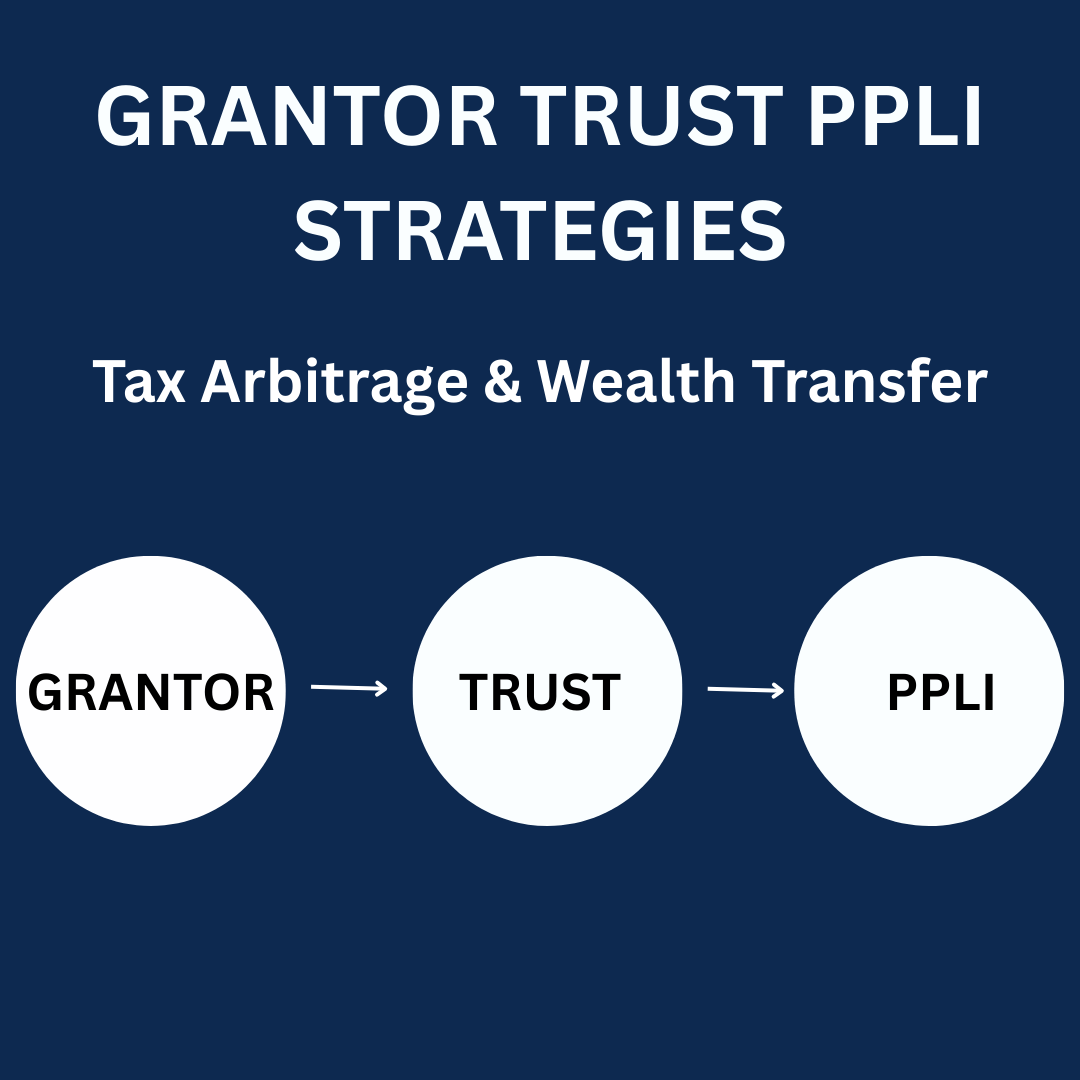Private placement life insurance (PPLI) combined with grantor trust structures presents exceptional tax arbitrage opportunities for high-net-worth families seeking to maximize wealth transfer efficiency while minimizing tax liabilities. These integrated strategies allow grantor trusts to pay income taxes on PPLI policy growth while transferring the economic benefits to beneficiaries, creating powerful tax arbitrage scenarios. The strategic use of grantor trusts with private placement life insurance enables families to accelerate wealth transfer, reduce estate taxes, and optimize investment returns through careful tax planning and structure design.
Understanding the Grantor Trust and PPLI Integration
Grantor trusts represent a unique tax planning tool where the grantor retains certain powers or benefits that result in the trust’s income being taxed to the grantor rather than the trust or its beneficiaries. When combined with PPLI, these structures create a powerful tax arbitrage opportunity where the grantor pays taxes on policy growth that economically benefits the trust beneficiaries. This arrangement effectively allows the grantor to make additional tax-free gifts to the trust equal to the income taxes paid on the trust’s behalf.
The integration of private placement life insurance within grantor trust structures provides multiple layers of tax efficiency. The PPLI policy grows tax-deferred within the trust, while the grantor’s payment of income taxes on this growth represents an additional wealth transfer that does not consume gift tax exemptions. This creates a multiplicative effect where both the policy growth and the tax payments contribute to the beneficiaries’ ultimate inheritance while reducing the grantor’s taxable estate.
Tax Arbitrage Mechanics in PPLI Grantor Trust Structures
The fundamental tax arbitrage opportunity in PPLI grantor trust arrangements stems from the ability to shift economic benefits while maintaining tax obligations with the grantor. When a grantor trust owns a private placement life insurance policy, the grantor remains responsible for income taxes on the policy’s deemed income, even though the economic benefits accrue to the trust beneficiaries. This creates a scenario where the grantor effectively makes ongoing tax-free gifts equal to the tax obligations.
The arbitrage becomes particularly powerful when considering the time value of money and the compounding effect of these tax payments over extended periods. Each tax payment represents an additional gift that does not count against annual exclusion limits or lifetime exemption amounts. Over time, these cumulative tax payments can represent substantial additional wealth transfers that would otherwise require the use of gift tax exemptions or result in gift tax liabilities.
Estate Tax Benefits and Wealth Transfer Efficiency
Grantor trust strategies with PPLI provide significant estate tax advantages by removing both the policy death benefit and the value of tax payments from the grantor’s taxable estate. The life insurance death benefit passes to trust beneficiaries free from estate taxation, while the cumulative value of income tax payments made by the grantor represents additional wealth transfer that would otherwise remain in the grantor’s estate. This dual benefit creates substantial estate tax savings over time.
The wealth transfer efficiency of these structures increases with the grantor’s tax rate and the length of time the arrangement remains in place. Higher tax rates result in larger tax payments and greater additional wealth transfer, while longer time periods allow for more cumulative tax payments and greater compounding benefits. The estate tax savings from removing these amounts from the grantor’s estate can be substantial, particularly for families subject to the highest marginal estate tax rates.
Have Questions?
Contact us by filling the form, and we’ll get back to you soon!
Contact Us
Generation-Skipping Transfer Tax Planning
Private placement life insurance within grantor trust structures provides exceptional opportunities for generation-skipping transfer tax (GST) planning by allowing families to leverage their GST exemption while continuing to receive tax benefits through grantor status. When PPLI policies are held in grantor trusts that qualify for GST exemption, the death benefits and accumulated tax payments can pass to multiple generations without additional transfer tax consequences.
The GST tax benefits become particularly valuable when combined with the long-term growth potential of PPLI policies and the cumulative value of grantor tax payments. These arrangements allow families to establish perpetual wealth transfer structures that can benefit multiple generations while maintaining the grantor’s tax obligations during their lifetime. The interaction between GST exemption allocation and grantor trust status creates opportunities for highly efficient multi-generational wealth transfer.
Income Tax Considerations and Planning Opportunities
The income tax treatment of PPLI within grantor trusts requires careful attention to ensure optimal tax outcomes while maintaining the desired trust structure. Grantor trust status ensures that policy growth and distributions are taxed to the grantor rather than the trust, preventing the imposition of compressed trust tax rates on policy income. This treatment is particularly beneficial when the grantor has lower marginal tax rates than the trust would face or when policy distributions can be timed to optimize overall tax efficiency.
Strategic planning around income recognition and distribution timing can enhance the tax benefits of PPLI grantor trust arrangements. The ability to control when and how policy distributions are made provides opportunities to optimize the grantor’s tax situation while maximizing the economic benefits to trust beneficiaries. These planning opportunities become more valuable as policy values grow and distribution options become more diverse.
Investment Flexibility and Asset Protection Benefits
The combination of grantor trusts and PPLI provides enhanced investment flexibility while maintaining asset protection benefits that are valuable for high-net-worth families. Private placement life insurance policies allow access to institutional-class investment strategies that may not be available through traditional trust investments, while the grantor trust structure provides additional planning flexibility around tax management and distribution strategies.
Asset protection benefits arise from both the life insurance structure and the trust arrangement, creating multiple layers of protection for policy assets. The creditor protection available through properly structured life insurance policies combines with the asset protection features of well-designed trust structures to provide comprehensive protection for family wealth. These benefits become increasingly valuable as policy values grow and family circumstances change over time.
Valuation Advantages and Gift Tax Efficiency
PPLI policies within grantor trust structures can provide valuation advantages for gift and estate tax purposes, particularly when policies are contributed to trusts at inception or during early policy years. The ability to transfer policies at values below their ultimate potential can create additional tax arbitrage opportunities through valuation discounts and the leveraged growth of gifted amounts.
Gift tax efficiency extends beyond initial policy transfers to include ongoing premium payments and the value of grantor tax obligations. Each element of the structure provides opportunities to transfer wealth without consuming gift tax exemptions or triggering additional transfer tax liabilities. The cumulative effect of these efficiencies can result in substantial tax savings over the life of the arrangement.
Administrative Considerations and Ongoing Management
Successful implementation of grantor trust strategies with PPLI requires careful attention to administrative details and ongoing management requirements. The coordination between trust administration, policy management, and tax compliance creates multiple touchpoints that require professional oversight and regular review. Proper documentation and record-keeping are essential to maintain the tax benefits and ensure compliance with applicable regulations.
Regular review and adjustment of these structures is necessary to maintain their effectiveness as tax laws change and family circumstances evolve. The flexibility inherent in both grantor trust arrangements and PPLI policies allows for modifications over time, but these changes must be implemented carefully to preserve the intended tax benefits and avoid unintended consequences.
Best Practices for Implementation
Effective implementation of grantor trust strategies with PPLI requires coordination among experienced tax, legal, and insurance professionals who understand the nuances of these integrated structures. Early planning and careful structure design are essential to ensure that all elements work together to achieve the intended tax and wealth transfer objectives. The timing of implementation can significantly impact the overall effectiveness of these arrangements.
Ongoing communication among all professional advisors is crucial to ensure that changes in one area of the structure do not negatively impact other elements. Regular review of tax law changes, family circumstances, and policy performance helps maintain the effectiveness of these arrangements over time and identifies opportunities for optimization or adjustment.
Conclusion
Grantor trust strategies with PPLI offer powerful tax arbitrage opportunities for families seeking to maximize wealth transfer efficiency while minimizing transfer tax liabilities. The integration of private placement life insurance with grantor trust structures creates multiple layers of tax benefits that can result in substantial savings over time. These arrangements require careful planning and ongoing professional management, but the potential benefits justify the additional attention and cost for appropriate families.
The tax arbitrage opportunities available through these structures continue to make them valuable planning tools for high-net-worth families, despite ongoing changes in tax legislation and regulations. As wealth transfer planning becomes increasingly important for affluent families, grantor trust strategies with PPLI provide a tested and effective approach to achieving tax-efficient wealth transfer objectives.
Ready to Explore Grantor Trust PPLI Strategies?
Book a Call





0 Comments